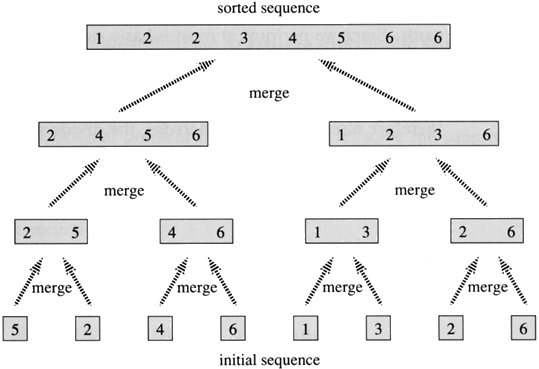Merge sort is based on the divide-and-conquer paradigm. Its worst-case running time has a lower order of growth than insertion sort. Like heap sort, merge sort requires additional memory proportional to the size of the input for scratch space, but, unlike heap sort, merge sort is stable, meaning that "equal" elements are ordered the same once sorting is complete.
To sort A[p .. r]:
1. Divide Step If a given array A has zero or one element, simply return; it is already sorted. Otherwise, split A[p .. r] into two subarrays A[p .. q] and A[q + 1 .. r], each containing about half of the elements of A[p .. r]. That is, q is the halfway point of A[p .. r].
2. Conquer Step Conquer by recursively sorting the two subarrays A[p .. q] and A[q + 1 .. r].
3. Combine Step Combine the elements back in A[p .. r] by merging the two sorted subarrays A[p .. q] and A[q + 1 .. r] into a sorted sequence. To accomplish this step, we will define a procedure MERGE (A, p, q, r).
Algorithm
MERGE-SORT (A, p, r)
{
IF p < r
THEN q = FLOOR[(p + r)/2]
MERGE (A, p, q)
MERGE (A, q + 1, r)
MERGE (A, p, q, r)
}
MERGE (A, p, q, r )
{
. n1 ← q − p + 1
n2 ← r − q
Create arrays L[1 . . n1 + 1] and R[1 . . n2 + 1]
FOR i ← 1 TO n1
DO L[i] ← A[p + i − 1]
FOR j ← 1 TO n2
DO R[j] ← A[q + j ]
L[n1 + 1] ← ∞
R[n2 + 1] ← ∞
i ← 1
j ← 1
FOR k ← p TO r
DO IF L[i ] ≤ R[ j]
THEN A[k] ← L[i]
i ← i + 1
ELSE A[k] ← R[j]
j ← j + 1
}
Graphical Representation

C Implementation
void mergeSort(int numbers[], int temp[], int array_size)
{
m_sort(numbers, temp, 0, array_size - 1);
}
void m_sort(int numbers[], int temp[], int left, int right)
{
int mid;
if (right > left)
{
mid = (right + left) / 2;
m_sort(numbers, temp, left, mid);
m_sort(numbers, temp, mid+1, right);
merge(numbers, temp, left, mid+1, right);
}
}
void merge(int numbers[], int temp[], int left, int mid, int right)
{
int i, left_end, num_elements, tmp_pos;
left_end = mid - 1;
tmp_pos = left;
num_elements = right - left + 1;
while ((left <= left_end) && (mid <= right))
{
if (numbers[left] <= numbers[mid])
{
temp[tmp_pos] = numbers[left];
tmp_pos = tmp_pos + 1;
left = left +1;
}
else
{
temp[tmp_pos] = numbers[mid];
tmp_pos = tmp_pos + 1;
mid = mid + 1;
}
}
while (left <= left_end)
{
temp[tmp_pos] = numbers[left];
left = left + 1;
tmp_pos = tmp_pos + 1;
}
while (mid <= right)
{
temp[tmp_pos] = numbers[mid];
mid = mid + 1;
tmp_pos = tmp_pos + 1;
}
for (i = 0; i <= num_elements; i++)
{
numbers[right] = temp[right];
right = right - 1;
}
}
Summary Merge sort is a fast, stable sorting routine with guaranteed O(n*log(n)) efficiency. When sorting arrays, merge sort requires additional scratch space proportional to the size of the input array. Merge sort is relatively simple to code and offers performance typically only slightly below that of quicksort.
